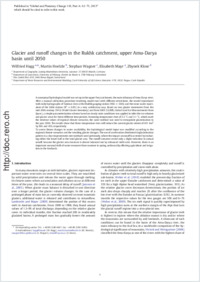Glacier and runoff changes in the Rukhk catchment, upper Amu-Darya basin until 2050
- Hagg, Wilfried Department of Geography, Ludwig-Maximilians-University, Munich, Germany
- Hoelzle, Martin Department of Geosciences, University of Fribourg, Switzerland
- Wagner, Stephan ITos-GmbH, 9642 Ebnat-Kappel, Switzerland
- Mayr, Elisabeth Department of Geography, Ludwig-Maximilians-University, Munich, Germany
- Klose, Zbynek Department of Water Resources and Environmental Modeling, Czech University of Life Science, Prague, Czech Republic
-
17.05.2013
Published in:
- Global and Planetary Change. - 2013, vol. 110, Part A, p. 62–73
English
A conceptual hydrological model was set up in the upper Panj catchment, the main tributary of Amu-Darya river. After a manual calibration procedure involving model runs with different restrictions, the model reproduced both daily hydrographs of Tanimas river at the Rukhk gauging station (NSE = 0.86) and the snow water equivalent of the Irkht station (R2 = 0.85) in a very satisfactory way. Based on two glacier inventories from the mid-20th century (WGI, World Glacier Inventory) and from 2003 (GLIMS, Global Land Ice Measurements from Space), a simple parameterization scheme based on steady state conditions was applied to infer the ice volumes and glacier areas for these different time periods. Assuming temperature rises of 2.2 °C and 3.1 °C, which mark the extreme values of regional climate scenarios, the same method was used to extrapolate glacierization to the year 2050. The results show that these temperature rises will reduce the current glacier extent of 431 km2 by 36% and 45%, respectively.To assess future changes in water availability, the hydrological model input was modified according to the regional climate scenarios and the resulting glacier changes. The use of an elevation distributed deglacierization pattern is a clear improvement over methods used previously, where the impact on runoff was tested by excluding either the lower half or the total glacier area. The runoff scenarios reveal only a slight reduction in annual runoff, because the glacier area decrease is almost balanced out by enhanced melt rates. However, there is an important seasonal shift of water resources from summer to spring, unfavorably affecting agriculture and irrigation in the lowlands.
- Faculty
- Faculté des sciences et de médecine
- Department
- Département de Géosciences
- Language
-
- English
- Classification
- Hydrology
- License
- License undefined
- Identifiers
-
- RERO DOC 209463
- DOI 10.1016/j.gloplacha.2013.05.005
- Persistent URL
- https://folia.unifr.ch/unifr/documents/303300
Statistics
Document views: 90
File downloads:
- hoe_grc.pdf: 445
